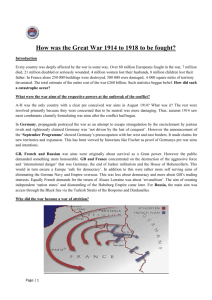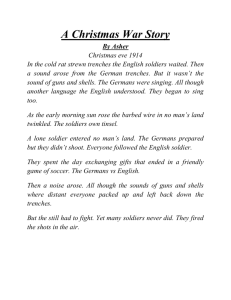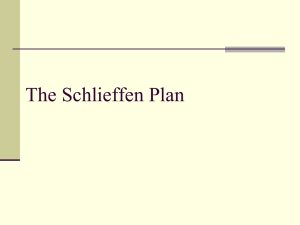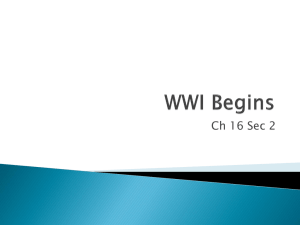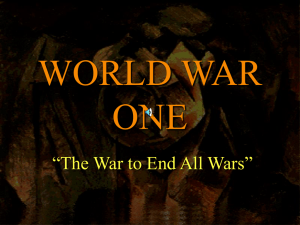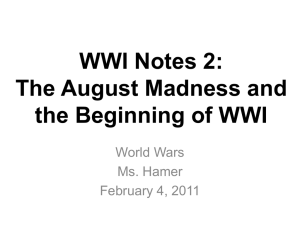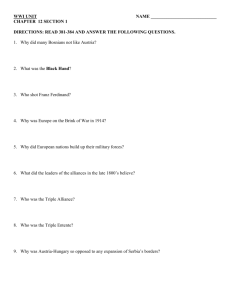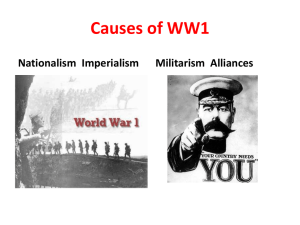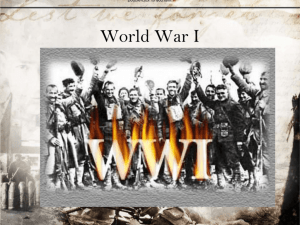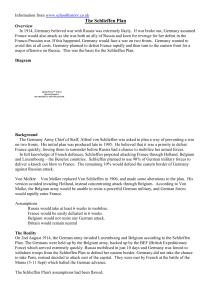What is a Trench? - Wiki del Colegio Newlands
advertisement
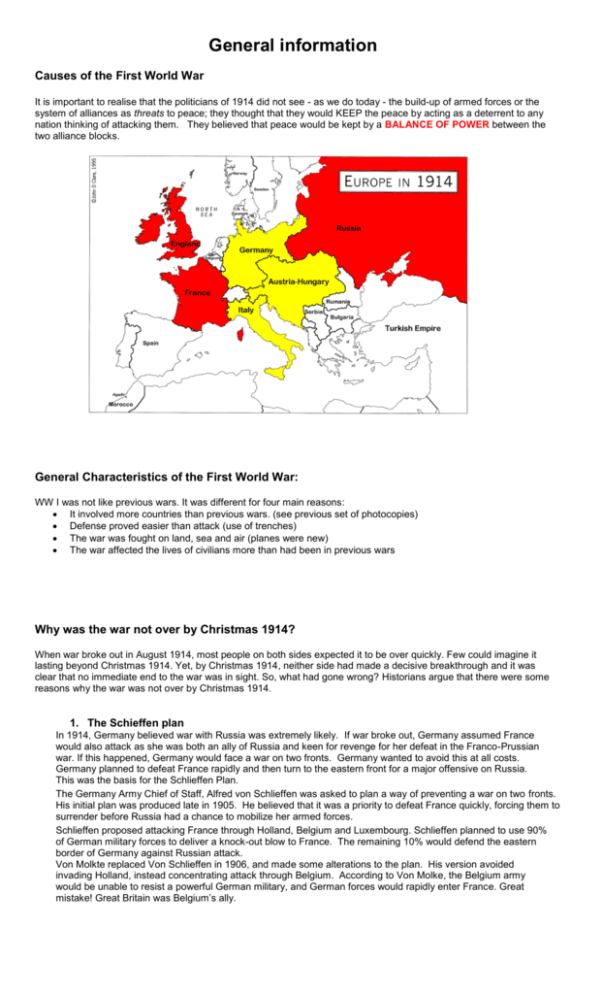
General information Causes of the First World War It is important to realise that the politicians of 1914 did not see - as we do today - the build-up of armed forces or the system of alliances as threats to peace; they thought that they would KEEP the peace by acting as a deterrent to any nation thinking of attacking them. They believed that peace would be kept by a BALANCE OF POWER between the two alliance blocks. General Characteristics of the First World War: WW I was not like previous wars. It was different for four main reasons: It involved more countries than previous wars. (see previous set of photocopies) Defense proved easier than attack (use of trenches) The war was fought on land, sea and air (planes were new) The war affected the lives of civilians more than had been in previous wars Why was the war not over by Christmas 1914? When war broke out in August 1914, most people on both sides expected it to be over quickly. Few could imagine it lasting beyond Christmas 1914. Yet, by Christmas 1914, neither side had made a decisive breakthrough and it was clear that no immediate end to the war was in sight. So, what had gone wrong? Historians argue that there were some reasons why the war was not over by Christmas 1914. 1. The Schieffen plan In 1914, Germany believed war with Russia was extremely likely. If war broke out, Germany assumed France would also attack as she was both an ally of Russia and keen for revenge for her defeat in the Franco-Prussian war. If this happened, Germany would face a war on two fronts. Germany wanted to avoid this at all costs. Germany planned to defeat France rapidly and then turn to the eastern front for a major offensive on Russia. This was the basis for the Schlieffen Plan. The Germany Army Chief of Staff, Alfred von Schlieffen was asked to plan a way of preventing a war on two fronts. His initial plan was produced late in 1905. He believed that it was a priority to defeat France quickly, forcing them to surrender before Russia had a chance to mobilize her armed forces. Schlieffen proposed attacking France through Holland, Belgium and Luxembourg. Schlieffen planned to use 90% of German military forces to deliver a knock-out blow to France. The remaining 10% would defend the eastern border of Germany against Russian attack. Von Molkte replaced Von Schlieffen in 1906, and made some alterations to the plan. His version avoided invading Holland, instead concentrating attack through Belgium. According to Von Molke, the Belgium army would be unable to resist a powerful German military, and German forces would rapidly enter France. Great mistake! Great Britain was Belgium’s ally. 2. The nature of the war The First World War was not like previous wars. It soon became clear that defense was easier than attack. One reason for this was the development of new small arms (machine guns) and better artillery (big guns and cannons) Also, armies in 1914 made use of railways to transport reinforcements to new positions. What is a Trench? Most of the fighting in the First World War took place in Belgium and France. By the end of 1914 millions of troops were dug into a long line of trenches which stretched from the North Sea to the Alps. Trench warfare characterised much of the fighting during the war, particularly along the Western Front. Trench systems were complicated with many interlinking lines of trenches as you can see in the diagram and drawing. Whatever their duties, soldiers spent a lot of time doing quite boring tasks there. They had to repair the trenches and wiring, moving rations and stores, cleaning, clearing, bringing in the wounded and burying the dead. Trench System Western Front The German army crossed the Belgian border on August 3rd 1914. Britain and France declared war on Germany on August 4th. The Germans pushed through Belgium, occupying Brussels before entering France. The British and French armies marched to stop the German advance. The Battle of Marne 4th - 10th September prevented the Germans from marching on Paris. To avoid losing the territory already gained in France, the Germans began digging trenches. The British and French unable to break through the line of trenches, began to dig their own trenches. Throughout the entire war, neither side gained more than a few miles of ground along what became known as the Western Front. The map shows the geographical position of the Western Front stretching from Belgium in the north to Switzerland in the south. Each coloured square represents 50,000 men. Yellow represents the German army, blue the French, red the British and orange the Belgian army. Eastern Front The line of fighting on the Eastern side of Europe between Russia and Germany and Austria-Hungary is known as the Eastern Front. Fighting began on the Eastern front when Russia invaded East Prussia on 17th August 1914. Germany immediately launched a counter-offensive and pushed Russia back. This pattern of attack and counter-attack continued for the first two years of the war and meant that the Eastern Front changed position as land was captured and lost by both sides. The map shows the geographical location of the Eastern front stretching from Riga in the north to Czernowitz in the south. The orange line shows the position of the Eastern Front in 1915. Each coloured square represents 50,000 men. Red represents the Russian army, yellow, German soldiers and blue Austro-Hungarian. Weapons During World War One a variety of weapons were used: Rifle The main weapon used by British soldiers in the trenches was the bolt-action rifle. 15 rounds could be fired in a minute and a person 1,400 metres away could be killed. Machine Gun Machine guns needed 4-6 men to work them and had to be on a flat surface. They had the fire-power of 100 guns. Large field guns had a long range and could deliver devastating blows to the enemy but needed up to 12 men to work them. They fired shells which exploded on impact. Gas The German army were the first to use chlorine gas. Chlorine gas causes a burning sensation in the throat and chest pains. Death is painful - you suffocate! The problem with chlorine gas is that the weather must be right. If the wind is in the wrong direction it could end up killing your own troops rather than the enemy. Mustard gas was the most deadly weapon used. It was fired into the trenches in shells. It is colourless and takes 12 hours to take effect. Effects include: blistering skin, vomiting, sore eyes, internal and external bleeding. Death can take up to 5 weeks. Zeppelin The Zeppelin, also known as blimp, was an airship that was used during the early part of the war in bombing raids by the Germans. They carried machine guns and bombs. However, they were abandoned because they were easy to shoot out of the sky. Tank Tanks were used for the first time in the First World War at the Battle of the Somme. They were developed to cope with the conditions on the Western Front. The first tank was called 'Little Willie' and needed a crew of 3. Its maximum speed was 3mph and it could not cross trenches. The more modern tank was not developed until just before the end of the war. It could carry 10 men, had a revolving turret and could reach 4mph. Planes Planes were also used for the first time. At first they were used to deliver bombs and for spying work but became fighter aircraft armed with machine guns, bombs and some times cannons. Fights between two planes in the sky became known as 'dogfights' Torpedoes Torpedoes were used by submarines. The Germans used torpedoes to blow up ships carrying supplies from America to Britain. The Germans torpedoed the passenger liner Lusitania on May 1st 1915 which sank with a loss of 1,195 lives. Americans were outraged and joined the war in 1917 on the side of the allies.
